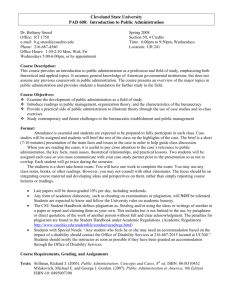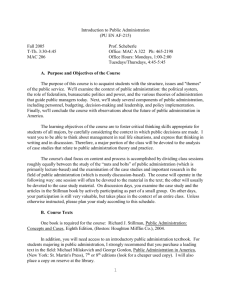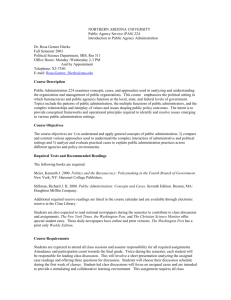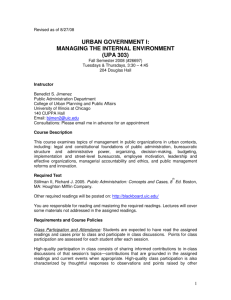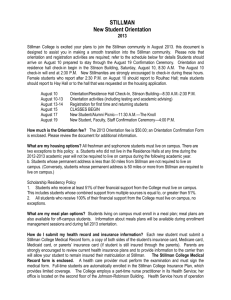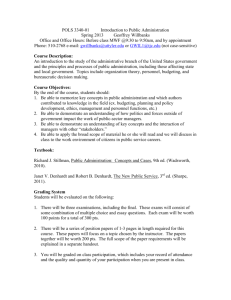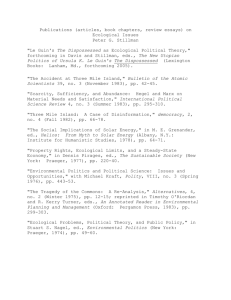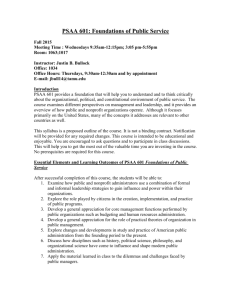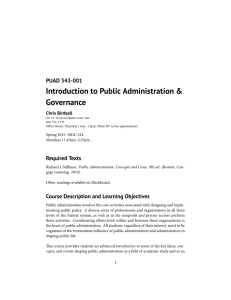UST 600 Section 50 Introduction to Public Administration
advertisement
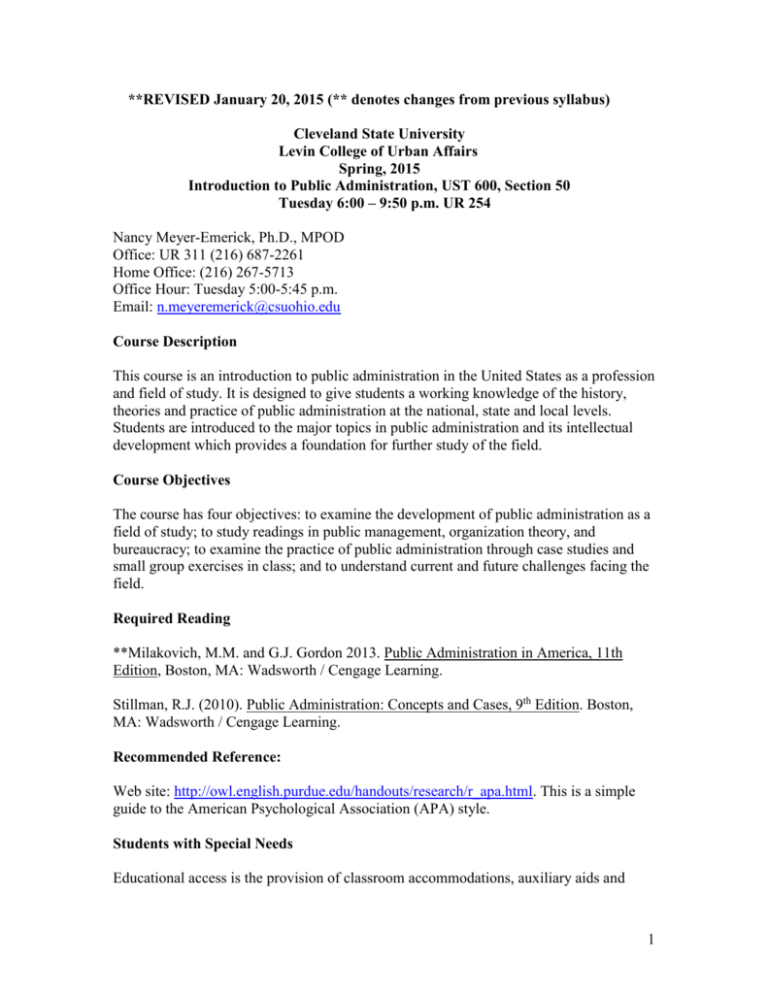
**REVISED January 20, 2015 (** denotes changes from previous syllabus) Cleveland State University Levin College of Urban Affairs Spring, 2015 Introduction to Public Administration, UST 600, Section 50 Tuesday 6:00 – 9:50 p.m. UR 254 Nancy Meyer-Emerick, Ph.D., MPOD Office: UR 311 (216) 687-2261 Home Office: (216) 267-5713 Office Hour: Tuesday 5:00-5:45 p.m. Email: n.meyeremerick@csuohio.edu Course Description This course is an introduction to public administration in the United States as a profession and field of study. It is designed to give students a working knowledge of the history, theories and practice of public administration at the national, state and local levels. Students are introduced to the major topics in public administration and its intellectual development which provides a foundation for further study of the field. Course Objectives The course has four objectives: to examine the development of public administration as a field of study; to study readings in public management, organization theory, and bureaucracy; to examine the practice of public administration through case studies and small group exercises in class; and to understand current and future challenges facing the field. Required Reading **Milakovich, M.M. and G.J. Gordon 2013. Public Administration in America, 11th Edition, Boston, MA: Wadsworth / Cengage Learning. Stillman, R.J. (2010). Public Administration: Concepts and Cases, 9th Edition. Boston, MA: Wadsworth / Cengage Learning. Recommended Reference: Web site: http://owl.english.purdue.edu/handouts/research/r_apa.html. This is a simple guide to the American Psychological Association (APA) style. Students with Special Needs Educational access is the provision of classroom accommodations, auxiliary aids and 1 services to ensure equal educational opportunities for all students regardless of their disability. Any student who feels he or she may need an accommodation based on the impact of a disability should contact the Office of Disability Services at (216) 687-2015. The Office is located in MC 147. Accommodations need to be requested in advance and will not be granted retroactively. Students should notify the instructor as soon as possible if they have been granted an accommodation through the Office of Disability Services. Important Dates This semester the last date to drop the class is January 23. The last day to withdraw from the class is March 27. Please contact me before you drop or withdraw from the class. Course Requirements Course grades will be based on the following criteria: Class preparation and participation – 10% Attendance and dialogue are important components of this course. You are expected to come to class prepared to thoughtfully discuss the assigned readings and to have completed the exercises within the chapters. Out of respect for your colleagues, laptop use and phone texting are not allowed during the class. Please contact me before class if you are unable to attend. You are responsible for obtaining notes and information from your colleagues if you miss class. Facilitate class discussion of a case from Stillman – 10% Each student will choose and facilitate one case discussion during the semester. Before the discussion give the class a 7-10 minute summary of the case including the main facts, the relevance of the case to that week’s reading, and practical lessons. Research proposal – 10% In order to make writing your research paper more enjoyable, you will prepare a 3-5 page research proposal detailing the research problem / situation, audience, proposed solution(s) and proposed literature search. You are encouraged to study and develop solutions to a public administration problem in your workplace. If you choose to do field research, I will help you submit your proposal to the CSU Institutional Review Board in order to protect human subjects. Note that the process may take up to four weeks so you must begin early in the semester. Please refer to the Guidelines for Research Proposal and Paper at the end of this syllabus. Midterm examination – 20% The midterm is a take home short essay exam. 2 Research paper – 25% The paper should be written using APA style and be 10-15 pages long. The paper should demonstrate your understanding of the public administration theory you are applying and some viable solution(s) using appropriate citations and at least 15 references from peer reviewed journals. You must submit your full paper, including references, to turnitin (a plagiarism checking site) before you hand it in to me so that you can see if you inadvertently plagiarized. If you do not do so, you will automatically lose 5 of the 25 points possible for this assignment. Presentation of research – 5% You will have an opportunity to share the results of your research with the class at the end of the semester. You will have 10 minutes to present followed by five minutes for questions. Final Examination – 20% The final will be a take home short essay examination covering material from the second half of the semester. Grades: Using this table as a guide, you will always know how you are doing in the course. A A- 94-100 90-93 B+ B 87-89 83-86 BC 80-82 70-79 F 69 or below Plagiarism Plagiarism is stealing and/or using the ideas or writings of another in a paper or report and claiming them as one’s own. This includes but is not limited to the use, by paraphrase or direct quotation, of the work of another person without full and clear acknowledgement. The penalties for plagiarism are found in full in the Student Handbook under Academic Regulations (Policy on Academic Misconduct) at the following link: http://csuohio.edu/studentlife/StudentCodeOfConduct.pdf. Course Outline – Reading Topics and Assignments Jan. 13 Introduction to Course Personal Introductions Research Project Brainstorming Jan. 20 Milakovich & Gordon, Chapter 1: Approaching the Study of Public Administration 3 Stillman, Reading 1.1: The Study of Administration (Woodrow Wilson) and Reading 1.2 The Study of Public Administration in the United States (Richard J. Stillman, II) Case Study 1: The Blast in Centralia No. 5: A Mine Disaster No One Stopped (John Barlow Martin) Jan. 27 Milakovich & Gordon, Chapter 2: Public Administration, Democracy, and Bureaucratic Power Stillman, Reading 2: Bureaucracy (Max Weber) Case Study 2: How Kristin Died (George Lardner, Jr.) Feb. 3 Stillman, Reading 3: The Ecology of Public Administration (John M. Gaus) Case Study 3: William Robertson: Exemplar of Politics and Public Management Rightly Understood (Terry L. Cooper and Thomas A. Bryer) Reading 4: Power and Administration (Norton E. Long) Case Study 4: The Columbia Accident (Maureen Hogan Casamayou) Feb. 10 Research Proposals Due at 6:00 P.M. Milakovich & Gordon, Chapter 3: Federalism and Intergovernmental Relations Stillman, Reading 5: From Cooperative to Opportunistic Federalism (Tim Conlan) Case Study 5: Wichita Confronts Contamination (Susan Rosegrant) Feb. 17 Milakovich & Gordon, Chapter 4: Organizational Theory Stillman, Reading 6: Hawthorne and the Western Electric Company (Elton Mayo) Case Study 6: American Ground: Unbuilding the World Trade Center (William Langewiesche) Feb. 24 Midterm Distributed Milakovich & Gordon, Chapter 5: Decision Making in Administration Stillman, Reading 7: Inside Public Bureaucracy (Richard J. Stillman, II) Case Study 7: The Decision to Go to War in Iraq (James P. Pfiffner) Reading 8: The Science of “Muddling Through” (Charles E. Lindblom) Case Study 8: How a City Slowly Drowned (Michael Grunwald and Susan B. Glasser) March 3 ** Midterm Due at 9:00 P.M. via Blackboard – No Class 4 March 10 Spring Break – No Class March 17 Milakovich & Gordon, Chapter 7: Public Personnel Administration and Human Resources Development Stillman, Reading 11: The Public Service Culture (Lois Recascino Wise) Case Study 11: Who Brought Bernadine Healy Down? (Deborah Sontag) March 24 Milakovich & Gordon, Chapter 8: Government Budgeting Stillman, Reading 12: The Politics of Public Budgets (Irene S. Rubin) Case Study 12: Death of a Spy Satellite Program (Philip Taubman) March 31 Milakovich & Gordon, Chapter 11: Government Regulation and Administrative Law Stillman, Reading 16: Public Administration and Ethics: A Prologue to a Preface (Dwight Waldo) Case Study 16: George Tenet and the Last Great Days of the CIA (Richard D. White, Jr.) April 7 Milakovich & Gordon, Chapter 9: Public Policy and Program Implementation Stillman, Reading 15: Public Policy and the Nature of Administrative Responsibility (Carl J. Friedrich); Administrative Responsibility in Democratic Government (Herman Finer) Case Study 15: Torture and Public Policy (James P. Pfiffner) April 14 Research Papers Due at 6:00 P.M. Milakovich & Gordon, Chapter 10: Performance Management in the Public Sector Stillman, Reading 9: Administrative Communication (Or How to Make All the Rest Work): The Concepts of Its Professional Centrality (James L. Garnett) Case Study 9: The Shootings at Columbine High School: The Law Enforcement Response (Susan Rosegrant) April 21 Research Presentations Milakovich & Gordon, Chapter 12: Conclusion: Public Administration in a Time of Conflict and Social Change 5 Stillman, Reading 14: Issue Networks and the Executive Establishment (Hugh Heclo) Case Study 14: Reinventing School Lunch: Transforming a Food Policy into a Nutrition Policy (Laura S. Sims) April 28 Research Presentations Final Exam Distributed ** Milakovich & Gordon, Chapter 6: Chief Executives and the Challenges of Administrative Leadership ** Stillman, Reading 10: Collaboration Processes: Inside the Black Box (Anne Marie Thomson and James L. Perry) Case Study 10: Government as Catalyst: Can It Work Again with Wireless Internet Access? Abhijit Jain, Munir Mandiviwalla and Rajiv D. Banker) May 5 Final Exam Due – No Class Guidelines for Research Proposal and Final Paper Format: The proposal and paper should be written in American Psychological Association (APA) style. This is a very simple author/date style that we will discuss in class. Please double space your paper, use a simple typeface (e.g., Times New Roman), 12-point type, and put a one-inch margin around the text. Make sure to number the pages and use paragraphs rather than spaces to separate groups of sentences. You may use headings and your final paper should include the results of any field research you have done. You do not need to prepare an abstract or use a running header on each page, but you should have a title page. Begin numbering the pages after the title page. State the problem: You will write this section for the proposal and then include it in the final paper but change the tense (from future to past). What specific public administration problem or policy do you want to study? Provide some background on the problem or policy in this section. Audience: You will write this section for the proposal and include it in your final paper. Who are you writing this paper for? Your tone will vary depending on who you are speaking to. Your audience may be the members of the class, or you may want to share your work with your supervisor. What do you think the solutions are? You will write this section for the proposal and include it in the final paper. Be very specific in stating what you think the solutions may be, especially if you have studied or worked on this problem in your agency. Provide evidence that your proposed solutions may solve the problem or improve the policy outcomes. 6 Literature search: For the proposal you will only need a sentence or two saying where you will look in the literature. Is the issue specific to a specific discipline (e.g., health care administration, law enforcement)? You do not need to list your references in the proposal, but you should include one reference in the text of the proposal and list it as a Reference to demonstrate that you understand APA citation. Your final paper however, must contain at least 15 references from peer-reviewed journals that you have found on your own. You must discuss each article in your paper. You may also use book references but these do not count towards the 15 articles. The CSU librarians are very helpful and a wonderful resource. The CSU librarian assigned to work with students in our college is Diane Kolosionek. Her email address is d.kolosionek44@csuohio.edu and her phone number is 216-802-3358. Research design: (Proposal) Explain, in detail, how you will test your proposed solutions. Most students will simply review the literature on their topic. Others may choose to do field research. If you do field research (i.e., interviews, surveys of your coworkers), you MUST submit your plan to the CSU IRB before you conduct the research but you only need 10 peer reviewed articles. Either way you must discuss your results in the paper, either by explaining how what you found in the literature compared with your initial thoughts about a solution or how you conducted your field research and what you found. We will discuss this process in class. Conclusion (for final paper only): Discuss whether the literature or field research supported the solutions that you proposed initially and how it can be applied to the problem / policy. Note: It is extremely important that you perform your research on your own time unless you have permission from your supervisor to do the work while you are on the job. A cooperative relationship with your supervisor is essential! If you do not believe you can safely study a problem in your organization, please discuss your proposal with me before proceeding. 7
